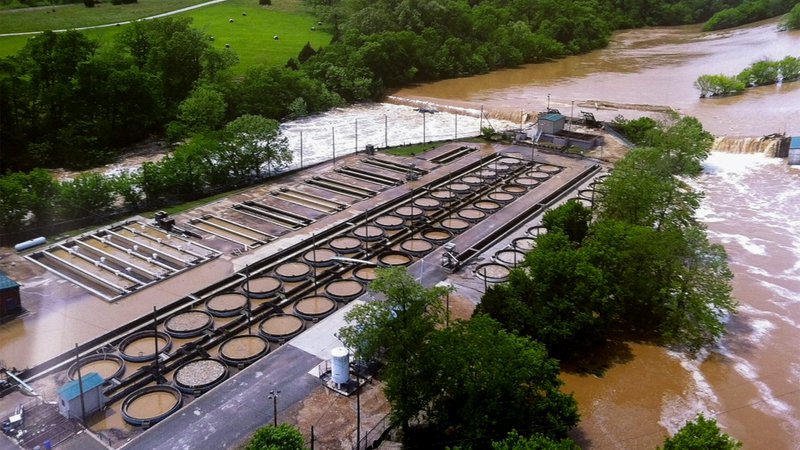Spring River hatchery fighting back against flood damage
BY agfc
ON 05-24-2017

May 24, 2017
The Arkansas Game and Fish Commission’s Jim Hinkle Spring River State Fish Hatchery in Mammoth Spring is recovering from widespread flooding that resulted from a storm on April 29 that dumped more than 8 inches of rain in the region.
Hatchery staff was forced to evacuate the facility the morning of April 30 as rapidly rising water in the Spring River threatened to overtop the island on which the hatchery is built. Hatchery manager Melissa Jones says the evacuation took place through the middle of the night and early morning.
“In flood conditions, it is necessary for hatchery personnel to be on site around the clock to ensure that water flow to the fish production units is maintained,” Jones said. “Rotating screens are used to manually remove woody debris and vegetation that can clog the hatchery water supply intakes, but those screens have to be maintained and cleaned regularly to supply water to the fish.”
As staff worked frantically to keep pace, the U.S. Geological Survey monitoring gauge at Cold Springs Access indicated a rise more than 9 feet, which forced hatchery staff to evacuate the island or ride the water out.
“There wasn’t much debate whether to stay or go when the water level rose 3 feet in one hour,” says Jones. “With the water still rising, we were able to remove all equipment, vehicles and staff safely off the island before the flood waters topped the only access road in and out of the hatchery.”
According to Jones, this is the highest she has seen the water in the hatchery during her 30-year tenure with the Commission and many in the community have compared this event to the December 1982 flood.
“Unfortunately”, said Jones, “due to the flood water topping the hatchery, we did experience a significant loss of fish, but some areas of the hatcheries fared better than others.”
The majority of fish in the raceways are thought to have escaped into the Spring River.
“Fishing is out of the world right now on the Spring River,” Jones said. “Anglers have reported excellent catch rates. The water has receded and is back to normal flow, so if I was looking for a great place to go trout fishing, I’d head to the Spring River.”
The hatchery is already rebuilding inventory to replace lost fish, thanks to partnerships with other state and federal agencies. Both U.S .Fish and Wildlife Service National Fish Hatcheries in Arkansas, Norfork and Greers Ferry, have provided close to 175,000 rainbow trout to grow out. Two USFWS hatcheries in other states, Wolf Creek in Kentucky and Dale Hollow in Tennessee, also have combined to provide AGFC with 185,000 3- to 4-inch fingerling trout. Along with fish from the USFWS, the Wyoming Game and Fish Department will be providing over 380,000 eggs for the hatchery to raise.
“This is huge,” said Jones. “A day after finding out about our situation, the U.S. Fish and Wildlife Service contacted AGFC and offered up these fish. I cannot say enough about the incredible partnerships we have with these other agencies.”
Although the Greers Ferry and Norfork hatcheries will continue to stock as scheduled, stockings from Spring River hatchery will see some reduction for the remainder of the year. In 2017, Spring River was scheduled to stock close to 800,000, 11-inch rainbow trout throughout the state. With the loss of fish, stockings will be reduced by close to 25 percent for the rest of the year.
Anglers concerned about how this may affect their fishing trips need not worry according to Trout Management Program Biologist, Christy Graham.
“We’ve recently completed angler surveys on three of the major trout fisheries in Arkansas,” Graham said. “Our results indicate that angler catch rates are high and that harvest rates are low, so a reduction in stocking should not be noticeable. Trout fishing across the state will remain excellent.”
The Trout Management Program has also recommended that the hatchery take this opportunity to provide anglers with bigger fish.
“With the reduced numbers at the hatchery, they will now have the space to raise fish to 12 inches before they are stocked,” Graham said. “Anglers have indicated in multiple surveys that they prefer quality over quantity, so we see this as an opportunity to make the best out of a bad situation.”
With fewer fish on site, Spring River staff will also have time to better assess potential changes to the hatchery’s aging fish-production silos. Jones says this was on the horizon, but the flood has upped its priority.
“We will be looking to develop a renovation plan and construct fish production units that better address biosecurity issues and prevent flood losses in the future.”
Recent News
Subscribe to Our Weekly Newsletter E-mails
Don’t miss another issue. Sign up now to receive the AGFC Wildlife Weekly Newsletter in your mailbox every Wednesday afternoon (Waterfowl Reports are published weekly during waterfowl season and periodically outside the season). Fishing Reports arrive on Thursdays. Fill in the following fields and hit submit. Thanks, and welcome!


